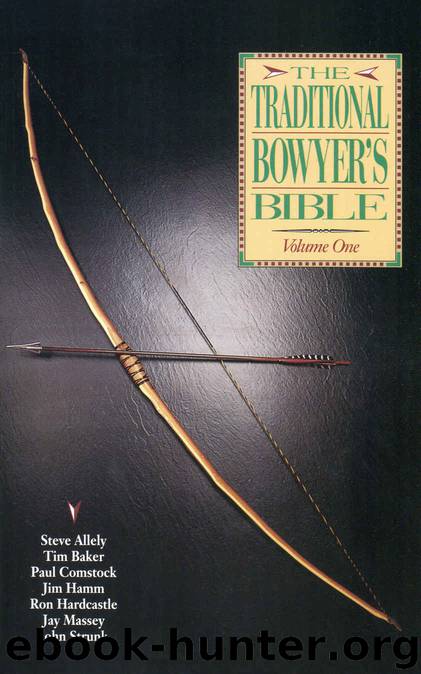Traditional Bowyer's Bible Volume 1 by Jim Hamm & Tim Baker & Jay Massey & Paul Comstock & Steve Allely

Author:Jim Hamm & Tim Baker & Jay Massey & Paul Comstock & Steve Allely
Language: eng
Format: mobi, epub, azw3
Publisher: Bois d'Arc Press
Published: 2015-01-17T16:00:00+00:00
WESTERN INDIAN BOWS
Steve Allely
In the fall of 1976, I was mule deer hunting in the high desert country of eastern Oregon. Despite not seeing any game, just walking in the fresh high altitude air, tinged with the scent of sage, was reward enough. While working my way up a small ridge where there were usually deer, I began finding pieces and fragments of obsidian points scattered about. Some were older atlatl points, while others were obviously made for use with the bow and arrow. The ridge wasn’t a village site, since most of the camps were situated around some nearby springs as evidenced by the presence of obsidian flakes and fire cracked rock. The points up on the ridge had been, in all likelihood, broken and lost during hunting since it was an excellent place to find deer browsing in the dim hours of dawn and twilight.
Being a flintknapper, I felt an affinity for these earlier hunters and craftsmen. They may have been “primitive” by modern standards, but there was nothing crude whatsoever about the beautifully flaked points I found lying about.
Keeping one eye on the ground for more points and the other out for deer, I followed the ridge to a pleasant opening in the middle of several mountain mahogany thickets. This was a prime place to sit and wait, I thought, since several trails came together there, and the visibility was good in all directions. It was ideal.
And that’s when I spotted it.
Nestled away in a clump of sage not ten yards away was an ancient stone hunting blind. The lichen-covered rocks had fallen down here and there, but the masonry work was still evident. Quite obviously someone else had considered this a good site in times past, and had perhaps brought down a mule deer or even a bighorn sheep on this very spot.
I began wondering in earnest about what kinds of bows and arrows the Indians once used in this place. Ironically, though the most disposable part of an archer’s tackle, the points were the only remaining article of all their bowhunting gear.
It dawned on me then that I didn’t really know much about what these points were once hafted to, much less what they were shot from, even though, as a knapper, I had made hundreds of points like the ones I’d been finding that morning. And to say nothing of quivers, manufacturing skills, materials used, hunting techniques and the like. Just replicating stone points was becoming old hat. What did the rest of the gear look like? I had to know. It was at that instant that the traditional archery “bug” bit me.
So from that point, I’ve been on a quest to find out more about the bows and arrows of the West Coast region, and have been fortunate enough to come up with some answers. Some were rare finds, such as the friend Ivan Sherk, who, as a boy, had been taught by an old Modoc Indian about hunting and making traditional bows and arrows.
Download
Traditional Bowyer's Bible Volume 1 by Jim Hamm & Tim Baker & Jay Massey & Paul Comstock & Steve Allely.epub
Traditional Bowyer's Bible Volume 1 by Jim Hamm & Tim Baker & Jay Massey & Paul Comstock & Steve Allely.azw3
This site does not store any files on its server. We only index and link to content provided by other sites. Please contact the content providers to delete copyright contents if any and email us, we'll remove relevant links or contents immediately.
Shoe Dog by Phil Knight(4167)
The Rules Do Not Apply by Ariel Levy(3906)
Walking by Henry David Thoreau(3234)
Running Barefoot by Amy Harmon(3057)
Crazy Is My Superpower by A.J. Mendez Brooks(2860)
How to Read Water: Clues and Patterns from Puddles to the Sea (Natural Navigation) by Tristan Gooley(2855)
I'll Give You the Sun by Jandy Nelson(2842)
How to Read Nature by Tristan Gooley(2665)
How Music Works by David Byrne(2526)
The Boy, the Mole, the Fox and the Horse by Charlie Mackesy(2449)
Seducing Cinderella by Gina L. Maxwell(2235)
Cuba by Lonely Planet(2184)
The Fight by Norman Mailer(2159)
Going Long by Editors of Runner's World(1921)
Accepted by Pat Patterson(1917)
The Unfettered Mind: Writings from a Zen Master to a Master Swordsman by Takuan Soho(1859)
The Happy Runner by David Roche(1821)
Backpacker the Complete Guide to Backpacking by Backpacker Magazine(1815)
Trail Magic by Trevelyan Quest Edwards & Hazel Edwards(1760)
